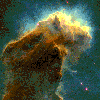The Hubble Space Telescope (HST) has returned some amazing pictures of our Universe. Below are two examples, showing the birth of stars in a Nebula. These images are from NASA which has a great web-site, where you can find loads of interesting images, and latest news.
 |
Gas Pillars in M16 - Eagle Nebula
These eerie, dark pillar-like structures are actually columns of cool interstellar hydrogen gas and dust that are also incubators for new stars. |
NASA quick links HST's
Greatest Hits Hubble
Picture Index NASA |
 |
Star-Birth Clouds in M16
This is a column of cool molecular hydrogen gas (two atoms of hydrogen in each molecule) and dust that is an incubator for new stars. |
|
 |
This stellar relic, first spied by William Herschel in 1787, is nicknamed the "Eskimo" Nebula (NGC 2392) because, when viewed through ground-based telescopes, it resembles a face surrounded by a fur parka. Dying star. | |
 |
The Hubble telescope has snapped a view of a stellar demolition zone in our Milky Way Galaxy: a massive star, nearing the end of its life, tearing apart the shell of surrounding material it blew off 250,000 years ago with its strong stellar wind. The shell of material, dubbed the Crescent Nebula (NGC 6888), surrounds the "hefty," aging star WR 136, an extremely rare and short-lived class of super-hot star called a Wolf-Rayet. Hubble's multicolored picture reveals with unprecedented clarity that the shell of matter is a network of filaments and dense knots, all enshrouded in a thin "skin" of gas [seen in blue]. The whole structure looks like oatmeal trapped inside a balloon. The skin is glowing because it is being blasted by ultraviolet light from WR 136. |